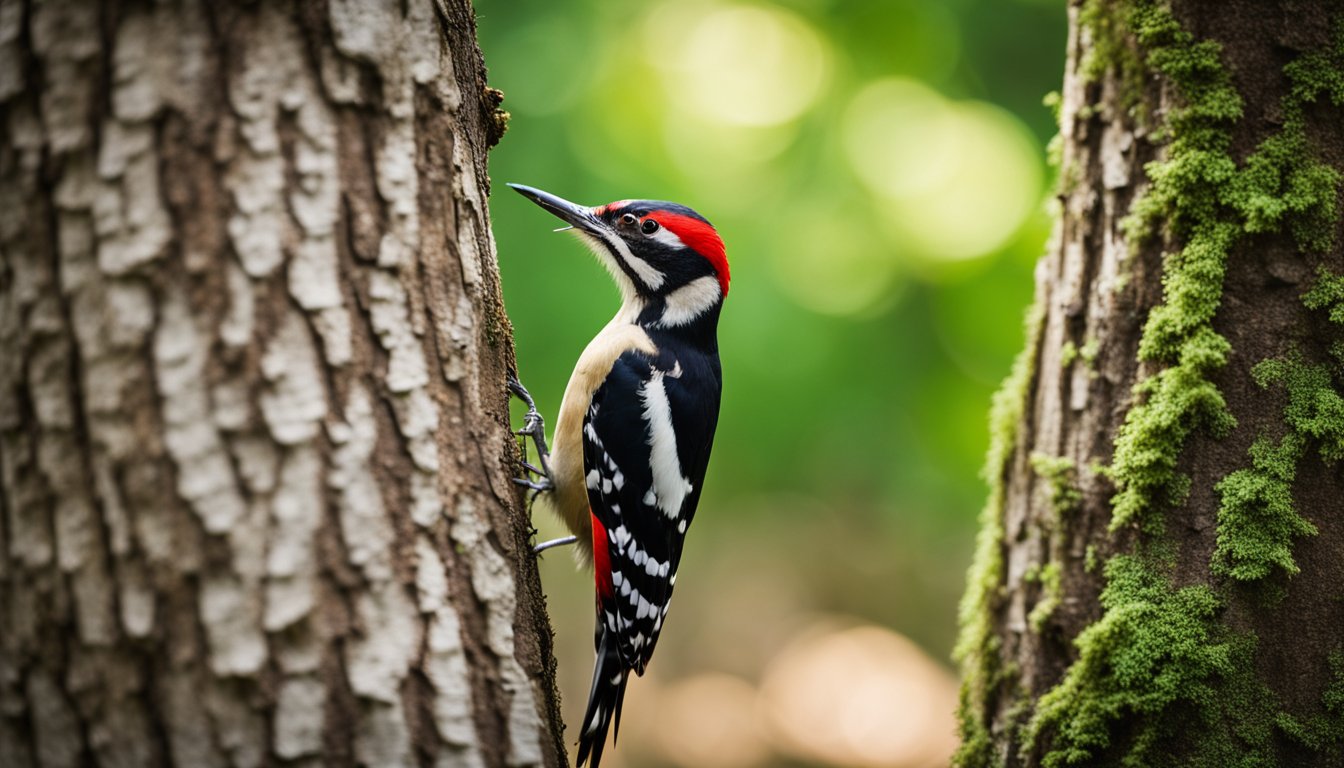The forest is full of sounds: leaves rustling, branches swaying and, if we listen closely, a rhythmic tapping that resonates through the trees.
This beat isn’t from a forest-dwelling drummer, but from woodpeckers, the natural percussionists of the wild.
These feathered friends use their beaks like drumsticks, pecking away at tree trunks to communicate, find food, and even attract a mate.
It’s a language of taps and knocks that carries across the canopy, and each species has its own signature rhythm.

As we explore the lives of these avian artisans, we discover that their drumming is more than just noise.
It’s a complex form of expression, integral to their survival in the forest.
Woodpeckers drum to mark their territory, warning others of their presence.
It’s a bit like us putting up a “Do Not Disturb” sign!
Also, just like we might knock on a melon to check if it’s ripe, these birds knock on wood to find insects hiding beneath the bark.
With each peck, they’re on the hunt for their next meal.
Have you ever tapped on a table to a tune, feeling how some spots sound different than others? Woodpeckers are experts at this game.
They can tell just by the sound if the wood is hollow, which means there could be bugs inside, or if it’s solid and they should peck somewhere else.
Their drumming speed is astonishing too—some can peck up to 20 times a second! Next time you’re in the woods, listen for that special tapping.
There’s a whole world of communication happening right above us, one peck at a time.
Woodpecker Species and Their Habitats

If you’ve ever wandered through the woods and heard a rhythmic tapping, chances are you were eavesdropping on one of nature’s finest drummers – the woodpecker!
These birds come in all sorts of colors and sizes, and they make their homes in a wide range of environments.
In this section, we’ll meet some of these feathery friends and discover where they hang out.
Diverse Dwellers of the Trees
When we talk about woodpeckers, we’re referring to more than 180 species that fall under the family Picidae.
Each one of these has its unique preferences for tree types and forest habitats.
For example, let’s take the famed Downy Woodpecker, which is our smallest variety in North America.
These little guys don’t mind living close to us humans and often set up shop right in our backyards.
They love to munch on insects hiding in the bark of trees and will happily visit a bird feeder or two.
Moving on, you might be surprised to find out that the Gila Woodpecker makes its home in the desert!
They’re pretty smart, as they carve out holes in cacti to keep cool in the scorching heat.
Imagine trying to stay cool by living in a cactus – pretty ingenious, right?
Forests and Beyond: Woodpecker Territories
Now, let’s adventure beyond the trees and into other interesting spots where woodpeckers like to call home.
The Great Spotted Woodpecker doesn’t limit itself to forests; oh no, it’s also found in parks and gardens across Europe and Asia.
But have you heard of the Imperial Woodpecker?
These impressive birds used to live in the mature forests of Mexico, often reaching about 60 centimeters tall—making them the largest woodpecker species!
Closer to the North Pole, in chillier habitats, lives the Black Woodpecker.
This bird carves out deep nests inside dead trees and doesn’t mind the colder weather. It’s like having your own cozy winter cabin right inside a tree!
Let’s imagine for a moment that you’re peeking out from a hole high up in a tree trunk; that’s the view many woodpeckers have from their homes.
Whether they’re in a bustling city park or deep in tranquil woods, woodpeckers have adapted to thrive all over our amazing planet.
Next time you’re out and about, keep your eyes peeled and ears open—you might just spot one of these resourceful creatures!
Anatomy of a Beat: How Woodpeckers Drum

Let’s get up close and personal with how woodpeckers create their signature forest rhythms.
It’s all about the amazing adaptations they’ve evolved over time. Are you ready to learn how these feathered friends drum their beats?
Tools of the Trade: Beaks and Skulls
We’re starting with the woodpecker’s beak, which is just like a drummer’s stick.
Their beaks are strong and pointed, perfect for tapping on trees. But it’s not just the beak that’s special; it’s also the skull.
Imagine wearing a helmet all the time; that’s what a woodpecker’s skull is like.
It has air pockets that cushion the brain, so when they’re drumming away, they don’t get a headache.
Rhythm in Motion: Muscles and Mechanics
Now, let’s look at their muscles; they’re real strong. Woodpeckers have powerful neck muscles that let them peck up to 20 times per second!
Can you tap your foot that fast?
They lock their toes around the tree, brace their tail feathers for support, and off they go, pecking in a perfect rhythm.
All these parts work together like a well-oiled machine to make the beat go on.
The Language of Taps: Communication and Courtship

In the forest’s orchestra, we’re the percussionists! Our taps are not random; they’re a complex language for chatting and flirting.
Woodpecker Morse Code
Imagine we’re tapping out secret messages on the trees, just like people used to send telegrams in Morse code.
Each tap, roll, and drumming pattern we create is our way to say “Hey!
This is my territory!” or “I’m looking for a friend!” Our rhythm can tell others a lot about us, like how strong or healthy we are.
It’s amazing how much we can say by pecking on our woody drums.
From Beats to Mates: Courtship Rituals
When springtime rolls around, our drumming takes on a whole new beat. It’s romance time in the tree-tops!
We start drumming more loudly and more often to catch the attention of a potential partner.
Each species of woodpecker has its unique love song, a special rhythm that only those of the same species will respond to.
It’s sort of like having a favorite dance that only the perfect dance partner would know.
And when two woodpeckers drum in harmony, it’s the beginning of a new feathered family.
Conservation and the Future

As we explore the woodlands, we often hear the familiar tapping and drumming of woodpeckers.
But have you ever stopped to think about how important it is to protect these striking birds?
Let’s dive into the world of woodpecker conservation and see what the future holds for our percussionist pals.
Threats to Woodpecker Populations
Woodpeckers face several challenges that can make their lives in the forest tough.
Habitat loss, which can happen when trees are cut down for wood or to clear land for buildings, is a big one.
Without the right trees to call home, woodpeckers can’t find enough food or the perfect spot to make a nest.
Another issue is climate change.
It can mess with the weather patterns and insect populations in the forest, making it harder for woodpeckers to plan their meals.
Diseases and competition for living spaces also put pressure on these birdies.
And let’s not forget about non-native species—animals and plants that aren’t originally from the area.
These intruders can sometimes push out the woodpeckers, taking over their homes and food sources.
Protecting Our Percussive Pals
Good news is, we can do a lot to help keep woodpeckers drumming.
By creating protected areas where woodpeckers can live without the worry of losing their homes, we give them a safe space to thrive.
These nature reserves are like big, leafy playgrounds full of all the things woodpeckers love.
We can also plant more trees and make sure our forests stay healthy and diverse.
It’s like throwing a big, green party that everyone is invited to, including bugs that woodpeckers dine on.
Plus, by being smart when we build new things, we can make sure there’s always room for trees and their feathery residents.
It’s all about sharing our space and working together to keep our forests full of life and music.
Frequently Asked Questions
Woodpeckers are skilled percussionists of the forest, fascinating us with their rhythmic tapping and drumming on trees.
Let’s explore some commonly asked questions about these feathery musicians to uncover the secrets behind their daily concerts.
Why do our feathered friends, the woodpeckers, tap on trees like tiny drummers?
Woodpeckers tap on trees primarily to find food. Insects hiding under the bark become snacks for our clever friends.
But that’s not all – they also drum to communicate with each other, marking territory and attracting mates.
It’s their way of sending messages across the forest, much like we might use our voices or phones.
Can you figure out when woodpeckers prefer to perform their rhythmic concerts in the wilderness?
Our little drummers are usually heard at dawn and dusk. These are their favorite times to chisel away and perform for the forest.
The quiet of these moments ensures their beats travel far, letting other woodpeckers know who’s around and ready to mingle or marking their forest home’s boundaries.
Is there a special meaning behind the patterns of taps and knocks you hear from the tree-tapping woodpeckers?
Indeed, the patterns of woodpecker taps and knocks are rich with meaning.
Each species has its unique rhythm, comparable to how we have different languages.
They might be searching for food, chatting with other woodpeckers, or even setting up a date!
Think of it as their Morse code, tapping out messages for those who understand.
Ever wonder why woodpeckers might mistake your house for a tree and start their drumming performance there?
Sometimes, our homes become stages for woodpecker performances.
They’re not really confused; it’s just that our houses have excellent acoustics to a woodpecker’s ears.
Eaves, siding, and even metal gutters can mimic the sound of dead trees, offering an irresistible concert hall for the birds to showcase their drumming prowess.
What’s the difference between a woodpecker’s drumming tune and its drilling work, and why does it matter?
The drumming of woodpeckers is all about rhythm and communication, while drilling is more like their day-job—done for foraging or creating a cozy nest.
Drumming is a rapid series of taps, a bit like a snare drum roll.
Drilling is slower, deeper, and focused, as if they’re slowly carving out the words of their own forest story.
Both actions are crucial to woodpecker life – one for speaking and one for living.
Can you guess which bird could be mistaken for a drummer with its call that sounds like a laugh echoing through the forest?
This one is a fun trick our ears play on us.
The laughing kookaburra of Australia is known for its call that sounds like rolling laughter through the trees.
Though not a woodpecker, this bird’s laughter reminds us that the forest is filled with myriad sounds, some resembling the beats and tunes we humans love so much!









